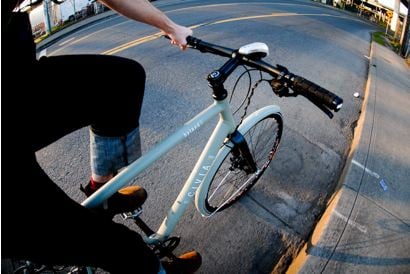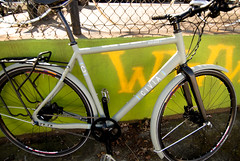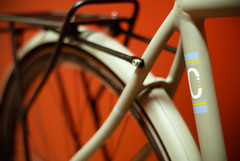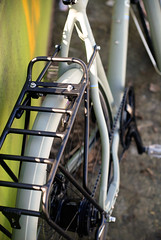
(Photos © J. Maus)
The latest addition to my test-bike stable is the new Hyland from Civia Cycles.
Civia is the just-launched, high-end commuter bike brand created by Quality Bicycle Products. “QBP”, as they’re known in the industry, is a Minneapolis-based bike parts and accessories distributor/juggernaut that serves over 5,000 bike shops and also owns venerable brands like Surly and Salsa.
I got my first look at this bike back in September when photos and specs hit the web after its debut at Interbike (a massive bike industry trade show held each year in Las Vegas). Civia raised my eyebrows for several reasons.
“Our audacious goal: Every family, every week, enjoying bicycles as transportation.”
–from the Civia website
First, with QBP, the brand had a solid pedigree and (I would assume) stable financial backing, a prerequisite for any bike industry endeavor. I’m not as close to the industry as I used to be, but I remember enough to know that QBP is a reputable and respected company that knows how to develop a successful bike brand. Second, I liked that they were boldy going after a high-end commuter market (that might not even exist yet) and they were doing it with a bike that at first glance seemed to be distinctive, sporty, functional and stylish enough to really catch on.
And finally, I appreciated that yet another major company was jumping head-first into designing and marketing bikes for transportation. It’s one of many recent signs that the bike industry is finally waking up to the American biking renaissance.
Or, as Civia puts it; “Our vision is to lead bicycling into its greatest era.”
So, when Civia brand manager Scott Thayer called and asked if I’d like to see one, I jumped at the chance. Unfortunately I’ve only got a few days to form an impression of the bike, but thanks to help from Mark over at Revolver bike shop, I’ve already got it built up and on the streets.
Civia offers the bike as a frameset only, or with a full Shimano Alfine component group ($1,985), a traditional derailleur build ($1,985 with XT components), or a Rohloff build ($3,150) that utilizes arguably the best internal hub/shifter on the market. Scott sent me the Alfine version.
With just a few rides under my belt, a few things jump to mind. Compared to other bikes I’ve tested (Batavus Old Dutch and Socorro, Electra Amsterdam, Bike Friday Tikit) this one is clearly focused more on performance and speed. It’s got a saddle you’d see on a racing bike, a straight-blade carbon fork, and handlebars with just a slight bend.
With several race-worthy parts from the likes of Salsa and Thompson, the bike comes in at well-under 30 lbs.
But as much of a speedster it’s made out to be, it’s also got some commuter-worthy highlights. These include a hub-generator front headlight, disc-brakes, full-wrap fenders, and a solid pannier rack.
Glaringly absent from my point of view is a bell, a rear light, a kickstand and a chainguard (update: chainguards will be standard with complete bikes): To me, a city bike feels naked without these essentials.
So how does it ride? I’m still forming my thoughts but my initial impression is that the bike is smooth, yet decidedly stiff, especially compared to the other bike I’ve been riding. I thought I wanted my perfect city bike to be sleek and fast, but now that I’ve got one that is, I’ve realized I’m looking for the better balance of comfort, speed, and predictable handling (especially with our roads in such disrepair).
Other thoughts about the ride experience so far: the Alfine components are elegant to the eye and smooth to the touch, and the metal fenders, although I appreciate them being color-coordinated, leave something to be desired. I’m a bit Type-A about noises, clicks and things being perfectly aligned on my bike, and these metal fenders seem excessively floppy easily bent.
Will the Hyland be the bike that lures would-be commuters to leave their Lexus at home? I’d like to think a snazzy, sleek, and functional bike could help make that happen. But the biggest hurdle for Civia, and others in the industry who hope to capitalize on commuting conscious consumers, will be convincing more Americans to get on a bike in the first place.
If the industry’s growing interest in the commuter market was coupled with similar efforts in the advocacy realm, than “bicycling’s greatest era” might actually be much more than a marketing slogan.
For more on the Civia Hyland, visit CiviaCycles.com or browse the comment threads at CommuteByBike.com here and here.
For more photos, browse the Civia Hyland photo gallery.







Thanks for reading.
BikePortland has served this community with independent community journalism since 2005. We rely on subscriptions from readers like you to survive. Your financial support is vital in keeping this valuable resource alive and well.
Please subscribe today to strengthen and expand our work.
I totally agree about a city bike being naked without lights, fenders and a chain guard. Reading your description and checking out the product on line all I can see is an averagely over designed hybrid. While these are worthy bikes to the right consumer they are nothing new. As always the specter of \’performance based recreational cycling\’ looms large in the mind of the designers who created this. From the evidence of this product it seems American bicycle manufacturers have a long way to go to fully grasp the reality of urban cycling and the \’real\’ needs of cyclists. I think that \’bicycling\’s greatest era\’ will not be defined by product but by people who saddle up and change the reality on the ground.
Seems to me that if they are looking to market this bike to get car commuters on bikes they may want to focus a bit more on function and a bit less on form (though it is a pretty bike to look at). If they want to entice folks from cars, they need to get the price down. otherwise, they won\’t get that market. Those folks new to biking but wanting to try the daily commute (more and more of them every day gas prices rise) will likely go Raleigh or something similar.
I think their market is a bit more upscale – as you observe via the reference to Acuras.
I think there\’s a market for this amongst Pearl dwellers and the like, even– nay, especially– at that price.
Me, I\’d spring for a Masi Soulville at a fraction of the cost, and way more cool, before I\’d spring for the Civia.
But to each their own. It is a beautiful bike.
The Civia website details a chainguard as standard although it is shown in only a few of the example pictures. The front fork is nicely sculpted with the fender and the front fender looks to extend well down in back and out in front. With all the attention to brake and shifter cable routing, they blew it for the front light. Pretty darn close but not quite the city bike of my dreams….
Better keep\’em inside. These things will go like hot cakes. I cannot imagine using a 2-3,000 dollar bike around town. Especially with with current fascination with locks as the solution to bike theft.
Seems like a good solution for the moneyed weekenders looking to \”be active\” and do novel things that involve a bike. But most people will do just fine with a sub-$300 Trek mountain bike and some slick tires.
Yes, most people are fine with sub-$300 mountain bikes. But, we are all people living in a capitalist society. People would all be fine with Honda Civics as well, but some people choose to drive luxury sedans or vintage roadsters.
Working in a bike shop I see people dip their toes into cyle commuting/touring with a $300 citified/touringized mountain bike bike, then they want something nicer/fancier/lighter/something-er so they get a $600-$1000 commuter/touring bike, but then, whats the next step when they \”outgrow\” this one? Pretty much the only next step presented by the mass-producted bike industry in this country is an \”elite\” version of the bike they just bought (carbon fork, disc brakes***, or some other things that are actually bad ideas for commuting/touring bikes). So, one option is to get a custom frame built for you, pay a several grand and wait a year or two (or more). Here is another option for a \”fine\” commuting bike. Its a trend thats coming back, the French used to spend three months pay on their bikes. When I was 17 in 1995 I bought a car for $1600. It lasted a year and a half, I could\’ve bought a Bridgestone RB-T, fully kitted it with racks, bags, dynamo ligthing system, etc etc etc, and I could still be riding it.
***Yes, I said it, disc brakes are bad for touring/commuting. Rotors get bent/contaminated, pads get contaminated, adjustments are FUSSIER than other brakes
It looks nice, but it won\’t sell here in TX. Most streets and trails here require something like a mountain bike or a suspended Hybrid. I tried to use a standard road bike for several months and had to rebuild the rear wheel 3 times and bought 4 headlights after they would get shaken to death. Then I switched to a WalMart BSO in the form of a full-suspension Mongoose 21 speed that lasted until it got hit with a truck after 13 months and 5500 miles of commuting.
And finally, I appreciated that yet another major company was jumping head-first into designing and marketing bikes for transportation. It’s one of many recent signs that the bike industry is finally waking up to the American biking renaissance.
It will be nice when there are more options in bike shops (across America, Portland is a bit \”different\”) than \”This is what Lance rides.\”
Hell, even Lance is opening a commuter shop. 😉
Style matters.
This thing will resonate with their upscale target audience. Sure a bike can be built up for less but not everyone is all about saving money. Where a frugal person says, \”It\’s just a few pounds heavier\” the well funded person says, \”It\’s just a few hundred dollars more.\”
While my commuter bike is quite cheap by comparison, it\’s similar in its function opting for speed and agility over comfort. Riders who commute with little cargo but go some distance will like the civia.
Please don\’t forget that new bicycles are like all other newly manufactured items – they still use resources and lots of power from our not so clean power plants, many, if not most, are made in areas with relaxed environmental regulations that ignore the severe pollution from aluminum plants and the like…
I\’m trying to say that while fancy new bikes are mighty attractive they still have a negative net impact on the environment – which is something I think about when folks talk about cycling to save the planet and all that.
To the big point – there are so many used bikes that are fully functional for any use. So if you\’re really trying to minimize your environmental impact or carbon footprint (I love the buzz words), then go used.
is it the flat paint job that makes it a thousand dollars more than the (QBP distributed) surlys crosscheck or long haul trucker? \’Cause if anyone wants me to wet sand there frame for a g I\’m ready and willing.
If you\’re looking for something that rolls more smoothly you might be able to get away with just getting fatter tires – especially if you get supple ones. Supple tires are faster than stiff ones, too…
sweet lookin rig.
For full on commuting, I just stick with my two 1975 Motobecanes, one a one speed, one a nine speed. They each cost about $200 to build up, so I worry not too much if someone cuts the lock and runs.
I have a nicer bike for long rides and when I go where I can watch it from where I sit in a restourant, etc. I have an off road for playing in the hills. But for commuting, I keep it cheap and simple, and those old Motobecanes, or any similar 70s bike roll just fine.
Criminy…for that price, I\’d call Rivendell…
Have you tried the Specialized Globe IG8?
It\’s aluminum…but it\’s like a quarterhorse…fast and agile.
Just like the old Specialized Globe except 10X more expensive.
I e-mailed them and told them to send me one. They stole my name for God\’s sake, I deserve a free one, no?
I\’ve got one on order with a late May delivery date. Its not my idea of a the perfect bike, but its close. It appears there was alot of thought that went into the options and design of the frame. Some of the respondents appear a bit to vehement in their views against the Civia I think they do protest too much.
I look at it like this ride what you like do as you may as long as it doesn\’t hurt anyone else.
I need a bike. I\’ve been commuting on a Trek Hybrid, but after 15 years, it\’s toast. So, should I go with Breezer Uptown 8 or pay more for the Hyland Civia? Is it worth $900 more?
Thanks,
Carl
These bikes are nice enough, but I agree that they are not very viable as commuters without a bell, full set of lights, fenders, chain guard, front and rear racks, and a repair kit (hello!). I fell in love with the handmade ANT bikes a couple of years ago and have been saving up for one… http://www.antbikemike.com — those are true bikes for transportation. With one of these bikes, I don\’t need a car.
I have a stable worth about $7k, so obviously I know the difference between a bike and a BSO.
The thing is, I live in WV, and walmart is the only place for just about anything.
I have a problem with our Walmart building bikes terribly. I mean, just flat out wrong.
http://wvcycling.wordpress.com/2010/04/14/more-wal-mart-woes/
I’m actually going to contact my walmart and hope to speak to someone and help them correct their problems, while not stepping on any toes. Wish me luck!